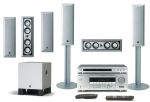Search engine visitors - click here to access entire "$ensible Home" web site
Dear Jim: We already have a big screen television and my children want a home theater sound system. I saw some rated at 600 and 800 watts which would be expensive to operate. How do I go about selecting one? - Kath N.

A: With both a big screen high definition television and a surround sound home theater system running, it can draw quite a bit of electricity, but not as much as you might think. The size of the television is not a good indicator of its operating costs. Its design type is more important.
The wattage rating you see on the packaging for a home theater system is the sum of the sound output from the speakers. A system that has six 100-watts speakers will be listed as a 600-watt system. If you look at the main power supply specifications, some may actually draw as little as 200 watts of electricity to produce that much sound. A powered subwoofer speaker will use a little more.
At an electric rate of nine cents per kilowatt-hour, installing a surround sound home theater system which uses 200 watts will cost about two cents per hour it is used. It is also wise to switch off the power when the movie is over to save a little more electricity from the sound system.
Since the cost to operate one is relatively low, most experts recommend buying the most powerful system (speaker wattage) you can afford, up to about 100-watts per channel. Above this, your children may crank it up and literally drive you out of the house. Higher wattage speakers on a low setting generally have less sound distortion than lower-wattage ones turned up.
There are several different sound formats you can select for your home theater. Dolby digital is most commonly used on DVD movies. It offers five distinct channels of sound plus a subwoofer for low frequency effects. The subwoofer is a large speaker that makes you actually feel a train go by.
Standard Dolby digital is often referred to as "5.1" for the five speakers and one subwoofer. A receiver (tuner/amplifier) control unit decodes audio information on the DVD movie into the five-plus-one channels of sound. The next step up is Dolby Digital EX which is 6.1 with an extra rear speaker. A competing sound format is DTS, but not as many DVD's and games use this.
Unless you understand audio equipment, it is best to buy a "home theater in a box." These are complete systems which include all the matched speakers, color-coded wiring and a receiver control unit. The most difficult part of installing one is trying to hide the wires leading to the rear speakers.
If you want to select individual components to make a system, make sure to purchase matching speakers of the same output wattage for the most true sound. You may consider getting wireless rear speakers to simplify installation.
The following companies offer home theaters in a box: JVC (800-252-5722 www.jvc.com), Onkyo (800-229-1687 www.onkyousa.com), Philips (800-531-0039 www.philips.com), Samsung (800-726-7864 www.sansung.com), Sony (800-222-7669 www.sony.com), and Yamaha (800-492-6242 www.yamaha.com)
There is no Update Bulletin with this column topic.
Dear Jim: I have gotten some quotes on adding insulation to my attic. One of the least expensive ones used chopped up old newspapers, I was told. Is this really a normal type of insulation people use in attics? - Denise D.
A: The insulation contractor is probably referring to cellulose insulation which can be made from recycled newspapers. It is usually blown into attics and, because it is lightweight, you can install it yourself.
Cellulose is treated with fire-retardant chemicals to make it safe for use in homes. It also has a slightly higher R-value per inch thickness than fiberglass batts and blown-in attic insulation.